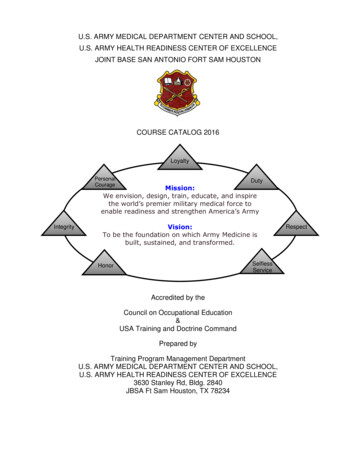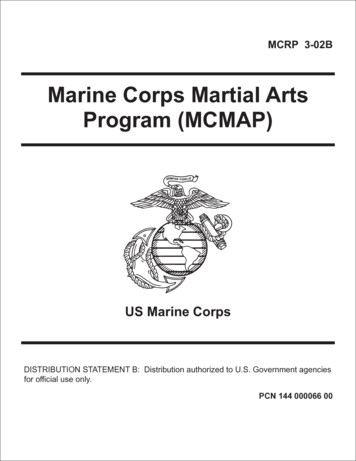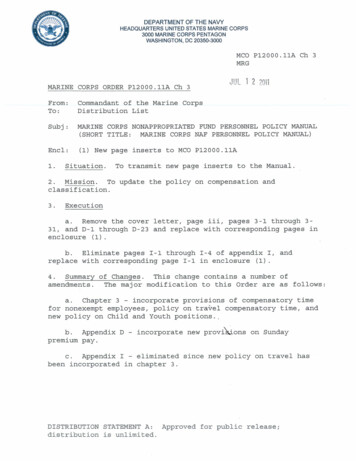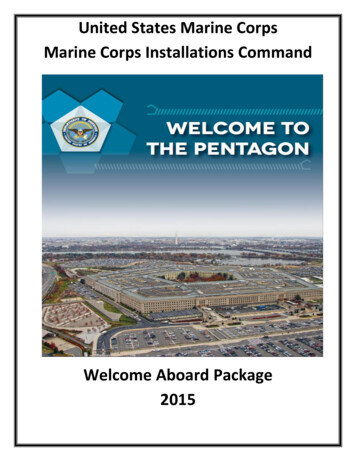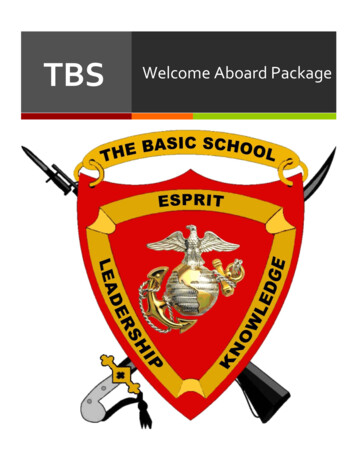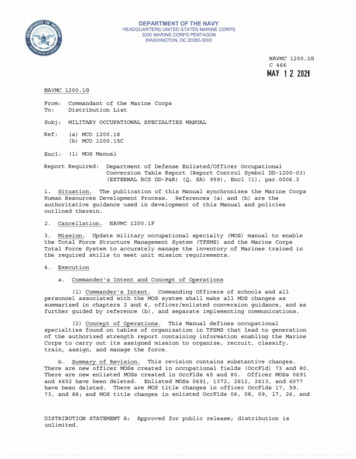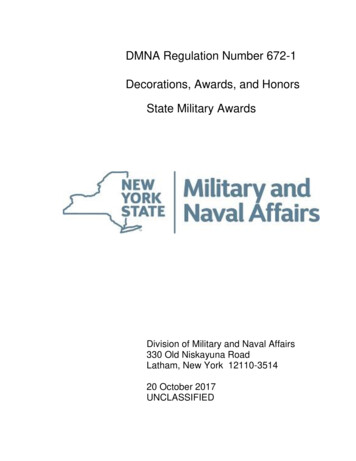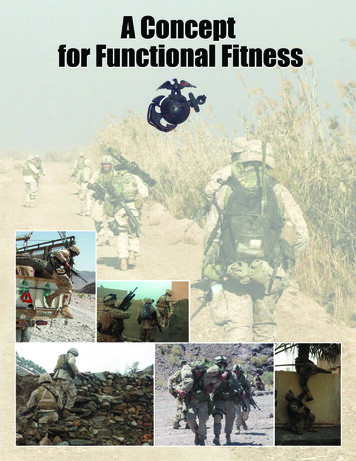
Transcription
A Concept for Functional FitnessThe United States Marine Corps has for many yearstaken pride in the level of physical fitness of its members.Physical fitness has been associated with professionalperformance, especially performance in combat. Thisassociation is correct because combat is the factor thatshould matter most to a fighting organization. However,the Marine Corps’ Physical Fitness Program, as it iscurrently focused and structured, does not adequatelyprepare Marines for combat. In fact, other than theinherent ingenuity that some forward-thinkingcommanders evidence, the focus of the program seems tohave only a mediocre combat focus at best. Further, mostunits find it difficult to follow the program as it stands,but even if the units did, they would still find that theirpeople were insufficiently prepared for the physicalrigors of combat.Marines are athletes. Their preparation for combat is notunlike a collegiate or professional athlete’s preparationfor his of her sport. There are some key differences of course. Marines do not know the exactgame they will be playing and they do not know the climate for the game. They do not know therules. Marines do not even know when they will be “playing.” However, these factors onlymake preparation more difficult for combat as compared to preparing for a season of sports.Many of the unknown (and unknowable) factors reinforce an argument that Marines need ageneral purpose sort of fitness—a fitness that is based on the functions of combat operations.Participation in combat operations should cause the Marine Corps to examine all aspects of theorganization for continued relevance. Recent combat operations have highlighted the need topay particular attention to our Fitness Program. Marines are being required to wear body armorand combat equipment an even greater percentage of the time. The mean weight for that bodyarmor has increased, especially with the addition of the SAPI plates. The helmet puts anunnatural load on the neck and the flak jacket puts a load on the lower back specifically and theentire body generally. These facts are not going to change anytime soon. Additionally, extremeclimates often require Marines to wear this organizational equipment in 120 degree heat whileperforming physical tasks that would be tough, even in the most temperate climates. These, andother environmental factors, only serve to exacerbate the super-human demands (physical stress)that combat will place on a Marine’s body.When a Marine is injured in training, the Marine usually misses subsequent training—and his orher level of fitness declines. When a Marine is injured in combat, depending on the nature of theinjury, he or she may spend months (or years) recovering. Physical therapy plays an importantrole in recovery. However, physical therapy without an integrated physical training program willnot be optimized.1
The Military ProblemPhysical preparedness is a job requirement (enabler) forMarines. Unfortunately, the Marine Corps’ current PhysicalFitness Program may not meet the needs of the organization.Current orders and doctrine may not optimally support acomplete fitness program that follows combat function. Theprogram over-emphasizes aerobic training (long distancerunning) and gives very little attention to strength training.Combat demands a fitness that follows function, based on corestrength and total body stamina. An unsophisticated exerciseroutine based almost entirely on mono-structural metabolicconditioning cannot provide the sort of training stimulusnecessary to build General Physical Preparedness (GPP).Further, the current program, unlike sports programs, placeslittle attention on “injury-proofing” Marines or on trainingaround an injury during “active recovery.”1Central IdeaMarines, as combat athletes, need a comprehensive fitness program that will develop thephysical skills necessary for combat; including core strength, endurance, speed, andcoordination. The Marine athlete should be prepared for the physical challenges of combat witha program that develops both GPP and Specific Physical Preparedness2—a program thatintegrates strength training based on functional, compound movements with multi-disciplinaryspeed, agility, and endurance training. The program should be intense and infinitely varied. Theprogram must also be interesting—we want Marines to stick with it.FitnessPhysical fitness is oriented on an ability to perform physical work. Combat poses an infinitevariety of physical tasks, many of which are foreseeable, some of which are not. This variednature of physical requirements and the fact that some aspects defy predictability, place anypreparation effort that is overly specialized at risk of irrelevance. Stated differently, the physicaldemands real life—and combat operations in particular—support the argument that a preparationeffort should promote a strong foundation of general fitness based on function.1Injury-proofing is a term to describe efforts to reduce the Marine’s risk of movement-related injury in training or incombat. Active recovery involves recuperation from intense exercise, overtraining, or even injuries using lowintensity exercises to increase healthy circulation, reduce the muscle soreness associated with lactic acid build-up inthe muscles and to maintain fitness. Active recovery can also aid psychologically in the healing process as theMarine athlete benefits from taking positive steps toward a restored physical condition.2Specific Physical Preparedness (SPP) emphasizes exercises that prepare the athlete for the challenges unique to aparticular activity. In this, the commander prepares the Marine athlete for his or her unique mission or occupationalspecialty.2
Functional Fitness DefinedFunctional fitness can be described as the ability to perform a broad array of natural or realisticphysical work. For Marines, that work involves all the tasks associated with performance incombat. The demands on the Marine’s body will vary with load and duration (factors ofintensity). A physical fitness that enables Marines to perform maximal combat-related workwould be ideal. In this sense, we are arguing that fitness should follow function—that combatfitness should be functional for combat. A preparation effort in which a program based onfunctional movements executed with representative intensity of combat should be most effective.“Functional exercise” involves multiple planes and multiplejoints. Most human action (work) seems to involve a relativelylimited number of fundamental movements (such as lifting,pushing, pulling, throwing, and locomotion). However, manyexercise routines (especially weight training or body buildingas it is popularly practiced) follow a “reductionist” approachthat strives to de-construct a movement in order to applyfocused stress on a singular joint and muscle group.Unfortunately, the human body does not work that way. Thebody works together as a system and exercises that serve tode-construct what are essentially irreducible (thoughadmittedly complex) movements, can create imbalance,unnatural stress on muscles and joints, do not generate an idealadaptive response, and most importantly do not mimic thereality that the Marine athlete will experience. "The key tofunctional exercise is integration. It's about teaching all themuscles to work together rather than isolating them to workindependently."3General Physical PreparednessGeneral Physical Preparedness (GPP) is a preparatory phase of trainingthat, " is intended to provide balanced physical conditioning inendurance, strength, speed, flexibility and other basic factors offitness " GPP exercises should involve as many muscle groups aspossible. Therefore, the cardiovascular demand will be greater and theperformance of more muscle groups will increase.4 General PhysicalPreparedness involves the formation, strengthening or restoration ofphysical skills which enable athletic or sports performance.53Gina Shaw, Working Out for Real Life Functions had Waterbury, Increase General Physical Preparedness, Dragondoor.com, Quote of Dr. Mel Siff.5Bryan Mann, General Physical Preparedness: The missing link in strength training, EliteFTS.com43
Important Elements of Marine Functional FitnessFitness should follow combat function.A Functional Fitness Program must be balanced in approach so that the Marine athletedevelops power, strength, flexibility, speed, endurance, agility and coordination.A Functional Fitness Program must have intensity and great variety.It ischaracteristically general and balanced. The intensity leads to positive physicaladaptation and the variety keeps the stimulus fresh and helps avoid over-training relatedinjuries. Repetitive exercise routines can actually serve to limit motion and stimulus andthis limitation can lead to dysfunction and injury.6 The great variety also helps to keepthe training interesting for Marines.A Functional Fitness Program must be scalable, allowing for the range of fitness levels ofvarious unit members. This scalability is an acknowledgement that Marines will havedifferent starting points in their personal fitness level and also allows the individualMarine to progress at his or her own pace. The program itself must be deliberatelyprogressive, working to improve physical skills and advance the Marine athlete’sphysical condition.Emphasis must be placed on making Marines “injury proof.” That is, by strengtheningthe muscles and joints and increasing bone density (another physical adaptation toexercise), Marines are less likely to sustain a debilitating injury resulting from physicalstress--either in training or once deployed. The Functional Fitness Program, in this sense,focuses on “prehabilitation”7 rather than waiting for an injury to actually occur andthereby having to resort to rehabilitation. Likewise, a Functional Fitness Program musthave an educational aspect in which Marines are taught efficient biomechanics forfunctional movements like running, lifting, jumping (and landing). The use of efficientbiomechanics in movement serves to reduce the incidence of injury and make the athletefaster and more agile. Essentially, the athlete is instructed on how to become a moreefficient machine—a machine that can perform optimally in the rigors of combat withless likelihood of injury.8When a Marine is injured through physical stress, he or she is more likely to recovermore rapidly if the body has been exposed to functional fitness exercise.9 Moreover,being injured is not a time to relax. A Functional Fitness Program will seek to minimize6Pete Egoscue, Pain Free, a Revolutionary Method for Stopping Chronic Pain, (1998, New York, Bantam Books),p. 273-2747Prehabilitation is a sports training term that acknowledges the role of injury prevention measures incorporated intoathletic training.8This admonition is based on a October 2006 interview with Walt Cline, M.S., C.S.C.S.,U.S.A.W., Director ofAthletic Development for Velocity Sports Performance, Alexandria, VA9William J. Kremer and Keijo Hakkinen, Strength Training for Sport, (2002 London, Blackwell Science, Ltd.), p.434
the period a Marine athlete spends in passive recovery10 and rapidly transition into somesort of active recovery. Marines can work around most injuries and continue training in asomewhat modified manner. In fact, the period of recovery from injury should be anopportunity to learn a new physical skill and become stronger in a new area. The bodywill tend to heal faster and the Marine will be stronger in the long run.When a Marine is injured in combat, he or she may face a daunting task of rehabilitation.Ideally, we want the Marine to be able to return to duty. However, even if that is notpossible, we want to restore the Marine to the optimal level of physical functionality thathe or she can achieve. Physical therapy and physical fitness can work almost seamlesslyhere to speed recovery. A Marine Functional Fitness Program must include this role inrehabilitation of injured warriors.The link in humans between the physiological and the psychological realms has beenwell established in science and medicine. This link has particular relevance to thedevelopment and preparation of Marines for battle. Combat stress is both physical andmental—and very real. Marines can sustain both physical and mental injuries in combat.Rigorous exercise can prepare Marines for these forms of battlefield stress by makingthem physically and mentally tougher. The stress of functional fitness can elicit bothphysiological and psychological adaptation. The principle here is that body can beconditioned to better handle combat stress. A Functional Fitness Program can play animportant role in this pre-combat conditioning by applying a “combat-like” form of stresson the human system—using rigorous exercise that mimics or mirrors combat function.The Functional Fitness Program is the commander’s program. The program must beflexible--adaptive to individual and unit requirements. The program must acknowledgethe need both for base fitness (GPP) and occupational or mission specific training. Acommander will adapt his program to integrate training based on the mission andoperating environment as he knows more about these. For instance, an infantry battalioncommander who knows he will bedeploying to a mountainous area (suchas Afghanistan) will elect to place moreemphasis on developing the physicalskills related to this mission. Coachesdo something similar with off-seasontraining that prepares the athletes tomake a smooth transition into preseason and in-season training.Ofcourse, Marines have no off-season, butsometimes commanders will haveadvance notice of their mission specificchallenges and will plan accordingly.10Passive recovery or rest recovery involves the Marine athlete refraining from physical activity to allow healing tooccur. While this type of recuperation is important, current studies indicate that the period should be judiciouslyminimized. The body is “designed to move” and movement stimulates recovery.5
What is new?In the past couple decades there have been many advancements in the fields of kinesiology(study of movement), exercise science, sports training and athlete development, and physicaltherapy. There have been fairly recent improvements in the understanding of humanphysiology—most of this emanating from college and professional sports. As sports teams lookfor ways to improve their athletes’ performance, “new” techniques are discovered for improvingindividual human performance more generally. While the importance of core strength andstability is not new, the emphasis is rather new. Sports as seemingly diverse as football,volleyball, and basketball are all seeing the advantages of developing core strength and stabilitythrough functional, compound movement exercises. We know that strength originates from thecore and extends to the extremities. Stability of the core provides the solid foundation that isessential for athletic movement, especially dynamic non-linear movement.What does this mean for Marines preparing for combat? Marines will be called upon to conductforced marches and patrols with heavy gear. They will have to cross obstacles of many types,especially in urban environments. Marines do a great deal of lifting, pulling, throwing, andmovement. In other words, they execute basic functional movements, and they do it under themost extreme circumstances—including being under fire. It is not an overstatement to say that aMarine’s life may revolve around his or her ability to move his weight—and maybe the weightof another Marine—around the battlefield. Conversely, though endurance is critically importantfor a Marine’s fitness, experience in recent combat operations has reinforced the idea that short,fast runs, normally under heavy load, are more the norm than long, endurance-type runs.Marines in combat service support are also called upon to work in rigorous situations in whichcore strength is an enabling capability. This principle applies to all Marines.What about the PFT?The current Marine Corps Physical Fitness Test (PFT) is aimed at giving individuals and units anindication of their respective level of physical fitness. As stated in the Marine Corps Order,Marines are in no way encouraged to train for the test, but rather to let the test demonstrate theircurrent physical state. If a Marine trains specifically and singularly for the test, his or herphysical fitness will likely be unbalanced because the exercises that are part of the PFT do not bythemselves develop functional fitness. A Marine could score well on a PFT and strain his or herback while lifting a pack or carrying a 155mm projectile to the loading tray. The problem here isnot with the PFT, but with the training. A Functional Fitness Program will have other tests aswell as the PFT. Individual Marines and groups of Marines will “test” themselves regularlyduring the course of their workouts. Commanders will develop physical training that stressestheir unit members to the point that genuine and meaningful evaluation is possible. In the samemanner that the Known Distance (KD) course establishes a baseline of proficiency, commanderswill continue to use the PFT to assess baseline physical fitness—and then they will press on withmore advanced and mission-focused training and assessment. In this, commanders will bedeveloping their own mission-focused test(s) and using these for the purpose of learning howeffective their Functional Fitness Program is.6
Implications for Combat DevelopmentIn order for a Functional Fitness Program to be ofutility—to really support the needs of commanders andtheir Marines—it must fit the culture andorganizational limitations of the Marine Corps. Thephilosophy and essence must be easily understandable,especially to Marine leaders who will be responsiblefor the program’s ultimate implementation, and forintegrating the elements of the program into unittraining. Commanders are always faced with timeconstraints, so the Functional Fitness Program mustabsorb no more time than the current program. The Functional Fitness Program must be sopractical, that commanders can, with a little creativity, integrate elements into other trainingevents as well. Some commanders may incorporate combat fitness into their commandphilosophy. Likewise, units always face budgetary realities which limit them to the purchase ofmission essential equipment. A new fitness program must be affordable.Marines should be introduced to Functional Fitness during entry level training and all follow-ontraining and education should include greater exposure to this practical, real-life form of fitnesstraining. Noncommissioned officers, SNCOs, and young officers should gain sufficientproficiency in Functional Fitness so that they are able to lead group and unit training and tomanage program development for their sections and platoons. Commanders should designate aFitness Coordinator for their units and these Coordinators (probably an experienced NCO orSNCO) will need to receive specialized training in the Functional Fitness Program.In a logical application of the “train the trainer” concept, therewill need to be some initial centralization of the program—probably at Quantico. In concept, trainers who receive moreextensive instructor trainer certification will need to travel outto bases and installations to teach and certify unit trainers.Major Subordinate Commands (such as Division Schools) mayprovide an ideal venue and structure for Functional Fitnesstrainers who can then in turn teach unit coordinators down toat least the battalion/squadron level and thereby perpetuate theprogram. This concept of training trainers is not withoutprecedent in that it is much akin to the Marine Corps MartialArts Program (MCMAP). Similarly, the British RoyalMarines have a system of unit Physical Training Instructors(PTI) that coordinate unit physical training and advise their unit commanders on physicaltraining. Of note, these seasoned NCOs have other primary jobs within their units. The PTI isan additional competency and responsibility.11 Unit Fitness Coordinators, in the same fashion asthe Royal Marine PTI, could develop and manage a unit program based on mission guidance11This information is based on an interview conducted by the author with Color Sergeant Chris Richards of theRoyal Marines in July 2006.7
from his or her commander. The Fitness Coordinator is the commander’s principal advisor onFunction Fitness and should be well-schooled on how to “customize” the unit’s program toprepare for anticipated combat requirements as a unit ramps up for anticipated deployment.Additionally, unit Fitness Coordinators should be able to teach Marines correct movementmechanics; therefore, these coordinators must be instructed themselves in proper technique.What about facilities and equipment?The Functional Fitness Program, as envisioned, does not require a great deal of sophisticatedequipment. Most of the exercises can be conducted with basic weight equipment such asbarbells, dumbbells, and medicine balls, chin-up and dip bars, jump ropes, boxes for box jumps,and some “cardio” equipment such as rowers and bikes. Running remains an important part ofthe program—but does not require equipment anyway. In fact, it should ideally require theacquisition only of a limited amount of basic, multi-use fitness equipment. Most of themovements associated with the Functional Fitness Program, since they imitate combat function,can be performed with a filled sandbag, a rock, a filled 5-gallon water jug, a tire, or an ammo canfilled with sand. Once unit leaders understand the philosophy of the program and they becomecreative, they will find all sorts of equipment” available to them. The whole argument aboutnecessary equipment was recently informed by an experimentconducted by the Canadian School of Infantry who conducted aprogram similar to the one described in this concept using“austere” equipment. In this experiment, they used ammo cansof various sizes filled with sand, large rocks, sand bags, andwater jugs filled with water. The results they obtained indicatedconvincingly that a quality functional fitness program can beconducted using materials at hand in any unit in anyconceivable location.12 Marines will be deploying on lengthycombat tours and must maintain their fitness while in combat.Marines can easily continue the Functional Fitness program,even in austere combat environments, and that fact makes theprogram particularly useful and practical.Summary13Now, after several years of participation in intense combat operations, is a good time to reexamine the Marine Corps Physical Fitness Program with an eye to revamp it to meet theemerging needs of the organization. This re-invigorated focus on combat-oriented fitness willcertainly be energized by Marines of all grades who have recently participated in combat12Reference to the Crossfit experiment conducted in the spring of 2006 by the Canadian School of InfantrySpecial thanks to Coach Gregg Glassman and his Crossfit organization. Coach Glassman was instrumental in thedevelopment of the principles of this concept. There are many authorities who are now advocating the functionalfitness method, but Coach Glassman’s Crossfit organization is probably the best single source representation of theideas in this concept. Many Marines are already trying his method and realizing results. For more information onCrossfit, go to www.crossfit.com.138
operations and who sense a need to make their training more relevant for what they experienced.The effort will not be without difficulty as change is never easy. This Functional FitnessProgram will be, for many Marines, significantly more challenging than anything they havepreviously experienced. Although the average time expended is equal to or less than what manyMarines are already accustomed to, the intensity andnature, being sufficiently stressful to causeadaptation, will seem initially intimidating to many.However, the program, properly administered, willachieve the kind of results Marines need in order tooptimally perform in combat. The key componentsof functional movement exercises of infinite variety,executed with intensity will lead to the core strength,system endurance, speed and coordination that bestenables combat effectiveness.As with any newinitiative, there will be “costs” associated, but theresults will speak for themselves—on the battlefield.9
Glossary of TermsEndurance--the ability to sustain a prolonged stressful effort or activityStrength--the ability to generate or apply force. Strength in the athletic sense that Marines areconcerned with, is a learned skill, requiring the development of muscle coordination—involvinga complex interaction of muscles that contract and relax in cooperative, but opposite actions.14Power is related to strength in that it is measured in terms of force over time. It is the rate atwhich work is performed.Speed—the swiftness or rate of performance or action or the ability to perform a movement in asshort a time as possibleCoordination--the harmonious functioning of muscles or groups of muscles in the execution ofmovementsAgility--ability to move the body quickly and easily or to transition from one movement toanotherAerobic training—“with oxygen”—physical work performed at a level of intensity that themetabolic system can keep up with the demand. Most “cardio” conditioning such as longdistance running, swimming, cycling, and road marches fall in this category.Anaerobic training—“without oxygen”—physical work performed at a level of intensity thatexceeds the metabolic capacity of the body, placing the body in oxygen debt. High intensitytraining such as sprinting, weight lifting and many sports involve activities which fall in thiscategory.Compound movements are “ multi-joint movements consisting of two or more joints movingand therefore many muscles are involved. One example is the Dumbbell Bench Press. In thisexercise you are moving at the shoulders, elbows, and wrists. You are utilizing the muscles ofthe chest, shoulders, triceps and a number of other muscles (i.e. synergists, stabilizers,antagonists, neutralizers, fixators) to complete the movement.”15Scalability—principle of taking a “standard” workout and making it more or less intense inorder to be appropriate for a wider audience of participants.Progressive exercise—concept that acknowledges the human body’s improved physicalcondition as a result of adaptation to physical stimuli. To maintain the positive adaptive stimuli,the exercise must be varied, particularly in terms of intensity.14Kremer and Hakkinen, Strength Training for Sport, p.11By George Stavrou, Back to the Basics: Big Movements for Better .html1510
Flexibility—is the ability of your muscles, tendons and ligaments to stretch which allow yourjoints to have a larger range of movement. This component is important to avoid injuries duringphysical activities.16 Of equal significance to athletes, flexibility allows the body to movethrough a greater range of motion with less internal resistance. This aspect is particularlyimportant for athletes in developing optimal speed, agility, and efficient athletic function.Flexibility can be improved through various forms of static and dynamic stretching. Static orpassive stretching involves holding a position. That is, the athlete stretches to their farthest pointand holds the stretch. In contrast, dynamic stretching involves deliberately moving the bodythrough a full range of motion—usually during a warm-up session. To be effective, flexibilitytraining should be conducted on a regular basis and should be incorporated into the exerciseroutine.16Wikipedia encyclopedia11
For more information, contact:Mr. Erik DoyleConcepts and Plans DeputyErik.Doyle@usmc.milLt Col Lance McDanielConcepts BranchLance.McDaniel@usmc.milPhone: 703-784-6605
A Functional Fitness Program must be balanced in approach so that the Marine athlete develops power, strength, flexibility, speed, endurance, agility and coordination. A Functional Fitness Program must have intensity and great variety. It is characteristically general and balanced. The intensity leads to positive physical



